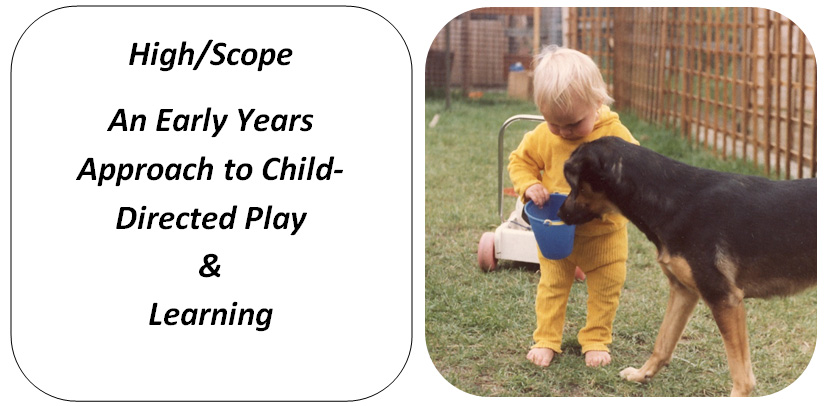
The relationship between the development of language and the development of thinking and reasoning embraces issues of communication, generalisation and socialization.
‘One of man’s most distinctive characteristics is his ability to use language. It permits him to behave more intelligently by tying together the past, present, and future. It captures concepts which are useful in solving problems.’ (Bernard1965:161)
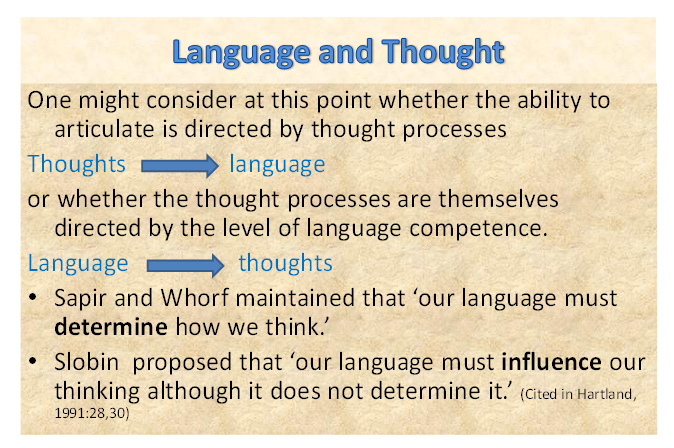
Contents
Introduction
- Engaging in Active Communication page 4
- Closed Questions page
- Open Questions
Choice and Adult Participation
Positive Listening and Communication Skills
The work of Piaget (1959) and Vygotsky (1986).
Egocentric Speech.
Socialised Speech
- The Development of Autistic Thinking, Egocentric Thought & Communicative Speech
- Cognitive Goals of Thinking
Active Learning
- Positive Adult-Child Interactions
A Child-Friendly Learning Environment
A Team-Based Daily Child Assessment
A Consistent Daily Routine
- Planning Time – (Planning)
- Work Time – (Doing) Recall Time – (Reviewing)
- Small Group Time
- Large Group Time
- Outside Time
- Transition Times
- Supporting Children in Resolving Conflict,
- Plan -Do-Review
The Role of the Adult Within High/Scope
Bibliography High/scope Education
Introduction
High/Scopeevolved as a practice based on the following three areas of study: practical interpretation of Piaget, observations of children, and traditional nursery school practices.
The adult’s role is predominantly informal with an emphasis on listening to the speech of the child, respectfully participating in the child’s pretend and role playing activities, and creatively supporting language development, which includes a special emphasis on verbal reflection of the child’s activities and disposition. (DVD,1986)
The following quote describes the three basic criteria which initiated the High/Scope preschool education programme.
1 ‘A coherent theory about teaching and learning must guide the curriculum development process.
2 Curriculum theory and practice must support each child’s capacity to develop individual talents and abilities through ongoing opportunities for active learning.
3 The teachers, researchers and administrators must work as partners in all aspects of curriculum development to ensure that theory and practice receive equal consideration.’(Hohmann, 2002:4)
The High/Scope approach presents that:-
- ‘learning comes from within’
- ‘personal initiative ‘directs the child’s active learning
- Control needs to be shared between the adults and children
‘The adult’s role is to support and guide young children through their active learning adventures and experiences.’ (Hohmann, 2002:3)
- The adults do not dominate, direct or overpower the child’s choices of activity and emergent style of learning.
In agreement with this approach R. Pinney presents that
‘the power to learn resides in the child’ (Pinney,1992:3-5) and that:- ‘In Learner-Directed-Learning the learner decides what, when, how much and in what manner he wants to learn…….‘ He is learning at his own pace at his own selection and in his own way…..’ (Pinney,1992:12&13)
Piaget describes the young child’s language as egocentric an outward expression of the child’s inner perspective. (Piaget,1956:244&273)Egocentric: only seeing how everything affects oneself and from one’s own point of view. The conscious concern with one’s own good. (Longman Modern English Dictionary.(2nd Ed.) Ed. Watson,1976) If the child’s egocentric perspective does direct the child’s learning and use of language, then the High/Scope role of the adult can understandably be established as supporter rather than director, andfacilitator rather than initiator.The wellbeing of the child is considered from a holistic perspective that acknowledges ‘the child as his own best expert’. (Pinney 1990)The adult is required to integrate their activity harmoniously with the quality of each child/ren’s situation, cronological age, ability, personal choices and insentives. Below describes aspectsrelated to the child/ren’s wellbeing that an adult may need to accommodate and assimilate before engaging in active communicationand subsequent interaction.
Engaging in Active Communication
- Maturation and experience
- ‘Learning oral language depends on good models, having something to communicate, and emphasis on the positive.’(Bernard1965:161)
- Motivation
- ‘Language not only provides a vehicle for communication, but it aids in the acquisition and preservation of new ideas.’ (Bernard,1965:148)
- Language skills
- ‘….. how complex are the functions of language, and how futile the attempt to reduce them all to one – that of communicating thought.’ (Piaget,1956:2)
- Social cooperation and social communication
- ‘Social organization is formed through communication, and its’ stability depends on facility in communication. ‘(Bernard1965:148)
- ‘Each function in the child’s cultural development appears twice: first, on the social level, and later, on the individual level; first, between people, and then inside the child.’ (Cited in Nelson,1996:19)
- Interpretation – analyses and synthesis
- ‘All of reasoning depends on information as well as on brain power necessary to utilise that information.’ (Bernard,1965:65)
- Sensory perception, habits and skills
‘Language plays a major role in the individual’s adjustment to his environment. ….conflicts between abilities, desires, and social demands are normal, and inconsistency of behaviour is normal. The fact remains, however, that the tendency toward integration is a fundamental aspect of growth.’ (Bernard1965:147,187)
High/Scope is a child-directed and child-centred education that incorporates a ‘Plan – Do –Review’ adult-pupil structurealongsidea specific approach designed to help the children resolve conflict. The strong emphasis on socialised play and language is presented as a positive influence on the children’s language development.(Hohmann, 2002)
The role of the adult within High/Scope is generally:-
Focused Attention on the child’s activity and communications
Reflective participation
For example: Enriching language content: vocabulary and descriptive language that is beyond what the child may have been able to present on their own within the play experience and/or reflective feedback which supports additional levels of consciousness within the child’s play activity.
Occasional activity related questions
This approach recognises the importance of the egocentric perspective within child initiated play and the potential for an adult to support a child extending into what Vygotsky describes as the child’s Zone of Proximal Development. (Vygotsky, 1986)The High/Scope approach emphasises the importance of open ended questions rather than closed questions:-
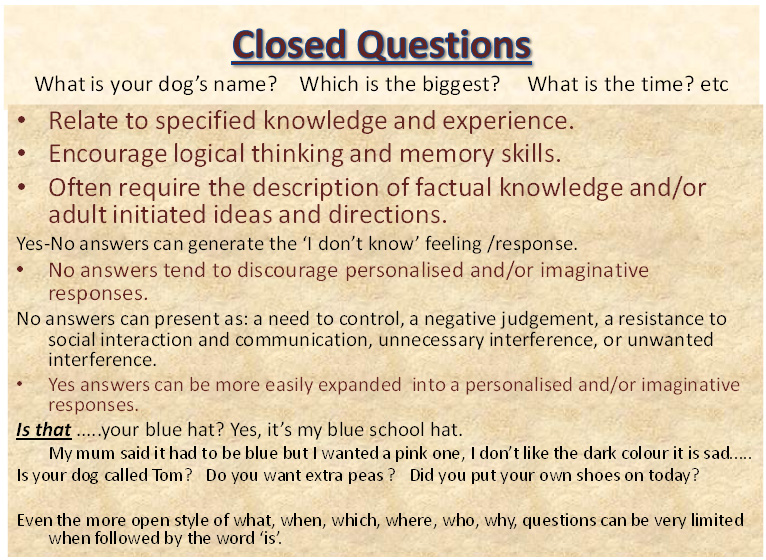
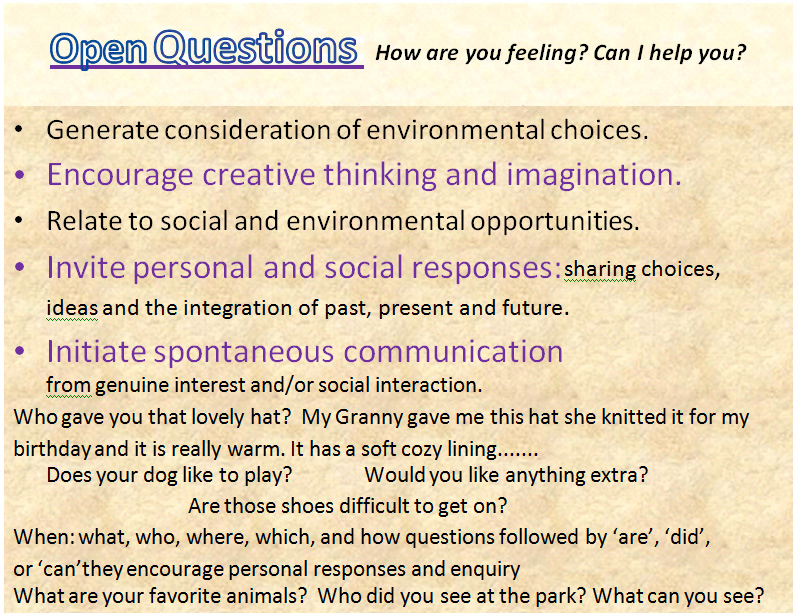
Choice and Adult Participation
The High/Scope methods also appear to emphasize the important influences that cultural experiences have upon the young child’s development of language and relationship to thought. This is illustrated in the daily High/Scope timetable which supports the children’s own responsibility for choosing what they want to do yet, at the same time, presents different social dynamics with specified adult participation: e.g. environmental enrichment guided by adult observations of the children, and activities that offer specified variations in group size and style of socialization.Young children are encouraged to share their play with the adults and clearly direct how they wish the adult to participate within their games.The adult may illustrate their companionship and attention as follows:-
Positive Listening and Communication Skills
- Passive Listening including appropriate eye contact and reassuring physical gestures/contact/holding
- Active participation through parallel or co-operative modes of interactive play.
Observation; extending,enriching and supporting the children’s play with the provision and organisation of environmental materials and subsequent follow-up activities.
- Active Listening.
This level of listening requires that the adult’s verbal responses, tone of voice, facial expression, gestures and body language directly relate to the child’s activity and harmoniously flow alongside the child’s activity and chosen modes of personal expression.Giving total attention to the child, consciously ‘switching off’ one’s own views, thoughts, desires and opinions, allows the adult’s full attention to be singularly focused on listening to the child.
- Reflection (Reflective Feedback)
Verbal representative feedback, describing with a simple and gentle commentary what the child is doing.Visual representative feedback, an imitative form of sharing that witnesses the child as director and the respondent as a keen and genuine apprentice. The adult engages in optimum levels of social interaction: reflection,positivity, sharing, imitation, compassion,enthusiasm andmost importantly anon-judgmental attitude.
‘..the practice of the Reflective Educative Facilitator would appear to offer unlimited potential for fostering and sustaining the imaginative life world of children.’(Trotman,2004:24)
Rachel Pinney suggests that ‘to be heard and appreciated is essential to a child’s growth.’She describes the adult skills related to ‘special times for listening to children’ as listening and recapping/reflection. ‘To receive absolute attention from the adult develops the power of concentration in the child’ and takes a level of attendance that may take some effort for the adult to attain.(Pinney,1992:3)
Auditory reflection initiated by the adult’s verbal feedback may encourage the child to engage in an ongoing process of spontaneous recall and review. Vygotsky proposes that ‘specifically human forms of psychological communication are possible because man’s reflection of reality is carried out in generalized concepts’ Vygotsky also describes how, when faced with a task that challenges them, children will often engage in a verbal conversation with themselves. (Cited in Hartland,1991:27; Vygotsky,1986:8&30)
This talking to himself, may illustrate what Piaget describes as an ego-centric monologue. (Piaget, 1956:8-9; Vygotsky,1986:18-19-227)
‘Listening is a principal source of learning throughout life…… The need for developing listening skills may in part be illustrated by personal reflection….. (Bernard1965:157)
Reflective responses from the adult appear to present a valid and informative description of a child’s actions that support and encourage:-
- Awareness and focused attention
- Enhanced association of knowledge
- Ability to evaluate sensory information
- Development of thinking and hypothesis
- Assessment of determining factors and appropriate redirection
- Long and Short-term memory
- Non pressurised self-directed learning
‘The need for developing listening skills may in part be illustrated by personal reflection…..’ (Bernard1965:157)
- Extending Observing the child’s play and supporting with the provision and organisation of environmental materials and subsequent enriching follow-up activities.
- Affirmation of success
Acknowledgement of what has been done well, even when it is only a few moments or a very small part of the overall activity.
Expression of authentic appreciation.
Identification of correct activity with positive responses.
The work of Piaget (1959) and Vygotsky (1986).
Fundamental aspects of the High/Scope system relate to children’s language development and the work of Piaget (1959) and Vygotsky (1986).
Piaget (1959) suggests that up to the age of seven ‘intellectual intercourse between children is still factual or descriptive’predominantly describing ‘actions and intentions’ or questions of reality, dealing with facts relating to naming and defining‘objects, events, time and place’ He also presents that through ‘knowledge of the physical world’ and ‘knowledge of others’ the child ‘finds himself in a physical and social universewhich he has never explored, he cannot therefore escape from making his own particular view of things created by the circumstances in which he is placed.’(Piaget,1956:31-32,164,270)
Piaget used the eight categories listed below to analyse the spontaneous speech presented by two six year old boys during their mornings at nursery. Piaget’sassessment did not include any spoken interaction initiated by an adult, which he suggests would have raised the children’s socialised language to a higher level.
The first three categories are grouped as speech without any specified communication purpose and headed :-
Egocentric Speech.
- Repetition (echolalia) – when verbal stimulus of syllables/words is imitated for the pleasure of talking and is ‘obviously devoid of any social character’.
- Monologue– ‘the child talks to himself as though he were thinking aloud.’
- Duel or collective monologue– where an outsider is somehow associated with the child’s spoken words, and yet the outsider’s presence serves only as a stimulus because he is not expected either to attend or understand what has been spoken.(Piaget,1956:9)
Piaget’sobservations noted that in the kindergarten children played amongst themselves and their language was predominantly spontaneous, and the above egocentric style was still pronounced between the age of six and seven, even though additional aspects of socialised speech haddeveloped.(Piaget,1956:105)
Piaget goes on to describe the following additional five categories as children’s communication that incorporates some form of intellectual process. He calls these additional categories:-
Socialised Speech
- Adapted information – a real exchange of thoughts, collaboration or simple dialogue, whereby the child speaking presents information that adopts the point of view of his hearer and thereby gains interest or influence.
- Criticism– ‘all remarks made about the work or behaviour of others’ these remarks often ‘asserted a superiority’ and ‘depreciated others’.
- Commands, Requests and Threats– where there is a definite interaction between one child and another.
- Questions– that called for an answer.
- Answers -when presented as a response to a genuine question.(Piaget,1956:10,11,21)
Piaget noted that the ‘collective monologue’ category of remarks was twice that of the category for ‘adapted information’. (Piaget,1956:21)This implies that for the two six year old children in his study the collective monologue was still an important part of their expressive language. He also noted a remarkable absence of discussion related to causal explanations,(Piaget,1956:22)and that children of this age do not support their statements with ‘because’ or ‘since’.(Piaget,1956:23)Aspects of intellectual logic are thereby limited to what he calls ‘primitive argument’. Piaget defines primitive argument as ‘collaboration in action’ which is aided by material objects relating to the children’s play/work, and thereby it is ‘bound up with action and devoid of explicit reasoning‘. Piaget calls this ‘acted’ conversation through which he suggests children understand each other well. Piaget suggests thissupports learning within environments that give children, up to the age of seven, freedom to play and learn together within a suitably equipped classroom of games and activities. Piaget presents that intellectual interchange is minimal– ‘reduced to the strictly necessary’ because for the young child language is used predominantly to ‘assist action’.(Piaget,1956:21-23,27&77-78)
‘The child does not in the first instance communicate with his fellow beings in order to share thoughts and reflections; he does so in order to play.’(Piaget,1956:27)According to Piaget the earliest form of thought is autistic. ‘Logic and socialized speech, from his point of view, appear rather late, and egocentric thought is the genetic link between autism and logic’.
Vygotsky, however, presents that the child’s earliest spoken language is socialized. (Vygotsky,1986:Xxxv)
Vygotsky presents that the development of autistic thinking, egocentric thought and communicative speech are interrelated but develop independently and remain an ongoing part of our language and thinking.
The Development of Autistic Thinking, Egocentric Thought and Communicative Speech
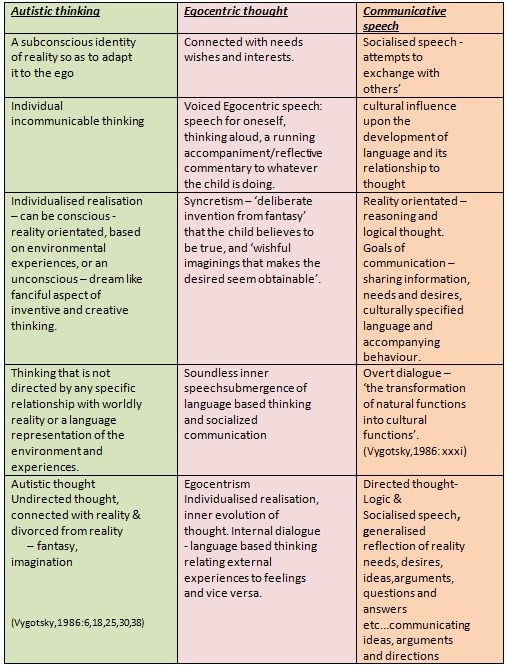
Vygotsky relatesthe young child’s progressive development of language and thought to their:-
- personalised relationship with reality,
- conceptual meaning of words,
- spoken communication. (Vygotsky’s,1986)
The chart below describes some progressive aspects of language and thought associated with the work of Vygotsky’s (1986) and Piaget.(1959).
Vygotsky (1986) presents that the development of autistic thinking, egocentric thought and communicative speech are interrelated but develop independently and remain an ongoing part of our language and thinking.
‘The cognitive function of egocentric speech, which is most probably connected with the development of inner speech, by no means is a reflection of the child’s egocentric thinking, but rather shows that under certain circumstances egocentric speech is becoming an agent of realistic thinking.’ (Vygotsky,1986:33)
Vygotsky wrote that ‘child egocentrism, therefore involves a certain unconsciousness , which in its turn explained some features of the child’s logic ‘and thereby the child during play may integrate without definition both directed and autistic thought. He illustrated that some ‘accidentally provoked egocentric utterance’ may directly influence how the child’s activity develops.(Vygotsky,1986:24,31)

Vygotskysuggests that educational approaches to the child’s development of language and thought ‘must be built upon three concepts: higher mental functions, cultural development, and mastering one’s own behavioural processes’,motivation, maturation and experience.Vygotsky proposes that ‘specifically human forms of psychological communication are possible because man’s reflection of reality is carried out in generalized concepts’ (Vygotsky,1986:Xxix,8)
Blooms describes the highest thinking skills as ‘Cognitive Goals of Thinking’:-
KNOWLEDGE COMPREHENSION APPLICATION ANALYSIS SYNTHESIS EVALUATION (Cited in Fisher, 1990:69)
In the chart below the author has added some proposed earlier thinking skills and some descriptive notes:-
Cognitive Goals of Thinking

The High/Scope curriculum and practice aims to support each child’s capacity to develop individual talents and abilities through ongoing opportunities for active learningbased on positive adult-child interaction that supports the child’s ‘personal initiatives’.(Hohmann,2002:5-6)
The five basic principlesthat form the ‘framework of the High/Scope approach.’ are presented by Hohmann(2002:7)as follows:-
Active Learning
- ‘Direct action on objects,
- Reflection on actions,
- Intrinsic motivation, invention and generativity,
- Problem solving. ‘….direct and immediate experiences and deriving meaning from them through reflection-young children construct knowledge that helps them to make sense of their world.’
Positive Adult-Child Interactions
- When children are ‘supported by adults who are genuinely interested in what they say and do children are able to construct their own understanding of the world around them and gain a sense of control and personal satisfaction…..’This emphasis on Adult-Child socialization is focused on participation, listening and sharing. Young children share their play with the adults, the children clearly direct how they wish the adult to participate within their games(Hohmann,2002:10)
A Child-Friendly Learning Environment
Children develop trust, initiative, curiosity, resourcefulness, independence, and responsibility.Adults observe, listen and record individual children’s ‘key experiences’ and notable incidents of joy, excitement, concentration, social and emotional interaction, discomfort or conflict.
Adults look for natural opportunities for:-
Conversation and use of ‘occasional questions to clarify understanding of the child’s thinking.’
In order to facilitate trust and an intimate exchange the adults position themselves ‘near the child at the child’s physical level’, so child and adult can ‘converse easily and comfortably’. (Hohmann,2002:10,287,213)
Parallel Play and Reflective Commentary with the children.
‘Listening is a principal source of learning throughout life….. The need for developing listening skills may in part be illustrated by personal reflection’ (Bernard,1965:157)
During parallel play the adult shares a play experience without directing or interfering with the child’s own play. The adult may imitate the child’s ideas and activities within their own authentic play agenda. During parallel play or simply from the position of observer, the adult may verbally reflect (describe) what he/she perceives is happening within the child’s play experience, presenting a valid and informative description of actions and events. This encourages the child’s awareness and association of knowledge, memory, consequences and experiential experiences. The reflective commentary illustrates the level of the adult’s attention and interest in the child’s activity and supports child-directed learning, self assessment and individual learning preferences. The reflective language presented by the adult may during this type of play reflect Piaget’s (1959) first 3 categories of Ego-centric speech. Thus the adult presents a familiar and possibly comforting feedback on the child’s own activities and simultaneously presents a reflective and enriching level of language accompaniment.
The reflective language presented by the adult may during this type of play reflectPiaget’s (1959) first 3 categories of Ego-centric speech. Thus the adult presents a familiar and possibly comforting feedback on the child’s own activities and simultaneously presents a reflective and enriching level of language accompaniment.
Play as a partner with children. Here the adult may present ‘conversational comments and observations that are supportive rather than burdensome and allow the child to retain control of the conversation’ and maintain control of the activity.The adult encourages the children to deal with problems and supports them with the High/Scope approach to conflict resolution where appropriate.(Hohmann,2002:196-197)
A Team-Based Daily Child Assessment
The High/Scope programme of observation and follow-up activities are based on a specified framework of ‘key experiences’.These ‘Key Experiences’ are seen to ‘promote the children’s mental, emotional, social, and physical growth’ through their invariably engagement in –‘creative, ongoing interactions with people, materials and ideas’(Hohmann,2002:5)
A Consistent Daily Routine
The following elements are structured to form a rhythmic daily routine specific to each class.
- Planning Time– (Planning)
When the adults share control with the children when childrenformulate ananticipated course of action. The children participate in the planning process each day and thereby grow accustomed to indicating their intentions before acting on them. ‘This helps children become conscious of their capacity to shape and control their own actions.’For the youngest children planning may be talking to themselves through which Piaget suggests ‘the individual experiences sufficient pleasure and excitement to divert him from the desire to communicate his thoughts to other people.’Even when the child’s response is facilitated by an adult communication, the child may present hisresponse as an action or a ‘collective monologue’.(Piaget,1956:18)
- Work Time–(Doing)
Through the spontaneous creativity of play the children engage in concentration, purpose, self-directed learning and playful pursuits.
Supporting strategiesfor the adults during Work Time are described as :-
Adults participation in children’s play.
Joining the children’s play at their level.
Looking for natural play openings.
Interpreting gestures and actions.
- Recall Time–(Reviewing)
Here the adult takes a more leading role,however, the priority is still listening to the children. The teacher is encouraged to ‘pick up on children’s opening comments’andencourage the children to reflect upon their Work Time activity. Occasionally the adult may present open ended questions (i.e. show me how…, tell me about what…..) about the children’s feelings, understandings and exhibits of what they have done/achieved. Recall time involves what and why questions, remembering, reflecting and clarifying past acts and experiences and associated plans, actions and outcomes.Piaget suggests that questions of ‘why’ when relating to causality are uncommon in children’s conversation prior to the age of 7-8 (Piaget,1956:) and children under seven only usually address questions of causality when they are initiated by an adult or an older child. However, ‘why’ questions play an important part in the questions young children,3 -7present to adultswho are supporting the children’s ‘spontaneous search for information’.
Recall time encourages the children to expand their consciousness beyond the present to embrace the past-present – future continuum as they describe their discoveries and actions.Piaget suggests that even young childrenusing primitive thought may ‘look upon the names of persons and objects and upon the designation of events as pregnant with the qualities of these objects and events.’(Piaget,1956: 23,30,3)
- Small Group Time
Periods when the same group of children meet each day with the same adult and share an activity and materials. This focused quality of sharing within the small group often encourages children to interact and discuss what they are doing.
- Large Group Time
When all the children and adults in a High/Scope programme gather together for ‘companionship, sharing important information, and the enjoyment of doing things together as a community’.The group activity is planned around the children’s current interest and key experiences. It may emphasise corporate play, a shared project or meaningful and enriching event.
- Outside Time
Children pursue active physical play engaging in unrestrained vigorous and noisy games outside, with the support of attentive, playful adults, and sharing experience of the natural world.
- Transition Times
When moving into and out of different stages of the daily routine children experience changes of activity, place and adult carers.
(Hohmann,2002: 18,168,2,236,269,282)
A notable foundation within the High/Scope approach to preschool education isthe Plan- Do- Review process.This process is predominantly facilitated through spoken communication and supporting aspects of the classroom environment. This process is associated with the individual child’s development of social interaction, socialised speech and reasoning.
The teacher’s role includes the prerequisite of detailed daily observation and listening, recording and assessment of individual children throughout the daily curriculum. The teachers are trained to note what High/Scope describes as ‘Key experiences – creative, ongoing interactions with people, materials and ideas that promote children’s mental, emotional, social and physical growth.’(Hohmann,2002:5)The key experiences are considered ‘guideposts’ that illustrate important aspects of each child’s ongoing development through his own actions and provide adults with a framework of understanding that helps them ‘provide optimum support’ through which the child can expand and revise his key experiences. The child’s personal development of descriptive language, and communication of personalised initiatives and social relationships appears to have a particular emphasis within adult-child interaction within the High/Scope curriculum of activities. (Hohmann,2002:298,230)
The High/Scope educational approach considers conflicts and disputes as a normal and important part of children’s learning. Piagetsuggests that ‘owing to the fact that all children are egocentric they will fail to understand each other properly’(Piaget,1956:119)since each child is only considering his own point of view.High/Scope teachers are trained to facilitate conflict resolution using six problem solving steps that help the children learn social, language and cognitive skills. Within each of the six steps the adult is presenting a role model of calmness and patience combined with a respectful, compassionateand non- judgmental disposition.
The following is a summary of the six steps presented by the video ‘Supporting Children in Resolving Conflict’, High/Scope Press. In brackets the author has added the key aspects of communication.
Supporting Children in Resolving Conflict,
- Approach quickly and calmly onto the children’s level, interrupt any hurtful behaviour and use the physical body to block any aggressive actionsand prevent any further antisocial action. Receive and initiate eye contact in a natural and appropriatemanner with each individual child. (Minimal language communication within a mood of gentleness and a sense of quiet)
- Acknowledge the children’s situation using simple statementsthat reflect the spontaneous speech of the child, give comments and present insightful questions. (Reflecting)
- Gather information listening very carefully to what the children say give each child plenty of time to communicate successfully. (Listening and Reflecting)
- Restate the problemusing as much of the children’s language as possible and rephrasing anything that could be hurtful or negatively judgmental. Help each individual child to clarify his own feelings and perspective on the problem. (Recapping and Reflection)
- Ask for ideas for solutions and support the children in coming to an agreement on a chosen solution and specify the practical steps to implement this solution. (Occasional Open-Ended Questions, Listening and Reflecting.)
- Be prepared to give follow-up support. Review what happened and if the problem has not been successfully resolved return to the point of the procedure that remains unresolved.(Listening, Reflecting, Recapping, and an occasional Question)
Within the High/Scope approach there appears to be a strong emphasis on passive reflection of the child’s egocentric perceptual and social disposition. Having acknowledged the child’s present level of engagement the supporting adult’s reflectivelanguage could facilitate further development of socialised language and thinking. In this way the adult reflects the child’s level of mental development at that particular time and encourages the child’s intellectual progress within what Vygotsky calls the child’s ‘zone of proximal development’.This can encourage the child to enhance and integrate more of his intellectual potential.
‘Spontaneous concepts that confront a deficit of conscious and volitional (willed)control find this control in the zone of proximal development, in the cooperation of the child with adults.’(Vygotsky,1986:194)
In this way Vygotsky presents that the development already established autonomously within the child extends into the potential for expanded intellectual thought when an adult provides an appropriate scaffolding of support and encouragement. (Cited in Nelson,1996:19)
In relation to language development adult facilitation for the child to function within his zone of proximal development are seen when the adult illustrates levels of language that arebeyond the child’s presentability. Thus, when functioning within his ‘zone of proximal development’ the younger child may be ‘scaffolded by the adult’(Nelson,1996:19)to communicate at what Piaget (1959) has presented as a more advanced level of socialised language development. For example Piaget describes notable differences in the child’s language development that occur between the age of seven and eight as:
– Arranging a story or an explanation in a definitive order.
– Genuine argument as collaboration in abstract thought.
– Why, where and how questions related to logical justification and reasoning.
(Piaget,1956:170)
The following chart is the author’s summary of the use of language in the High/Scope curriculum as illustrated within the Plan -Do-Review approach and the specified adult support for Conflict Resolution.
Plan -Do-Review
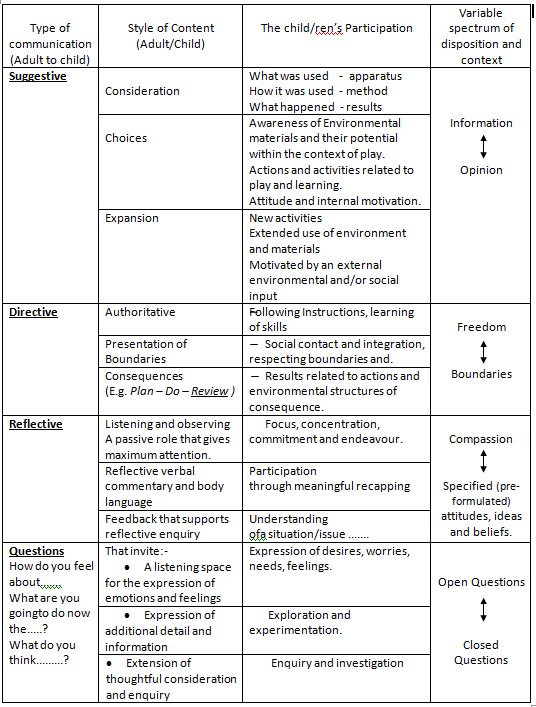
The High/Scope methods also appears to emphasize the important influences that cultural experiences have upon the young child’s development of language and its relationship to thought. This is illustrated in a timetable which supports the children’s own responsibility for choosing what they want to do, yet at the same time presents different social dynamics with specified adult participation: i.e. environmental enrichment guided by adult observations of the children and activities that offer specified variations in group size and style of socialization.
The diagram below Hohmann(2002:7) illustrates the five basic principles that form the ‘framework of the High/Scope approach.’

The concluding chart summarises the High/Scope approach to supporting/scaffolding children’s development during their early years within a play and learn philosophy.
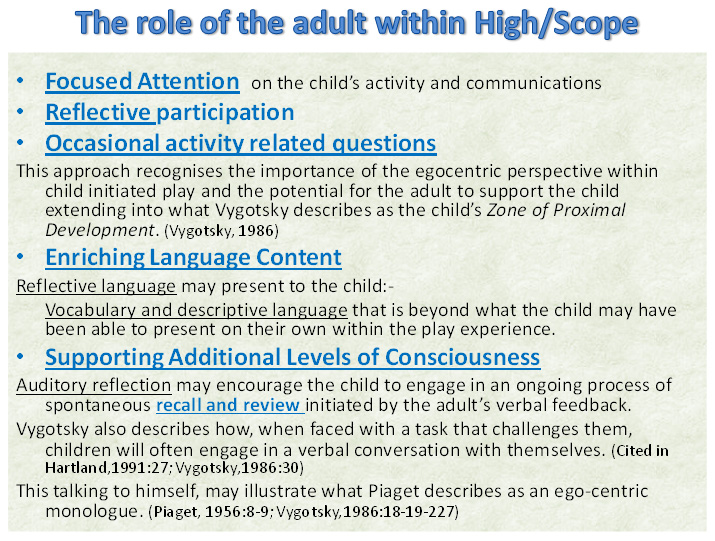
Bibliography High/scope Education
Athey, C. Extending Thought in Young Children. London: Paul Chapman, 2007.
Bernard,H.W. Psychology of Learning and Teaching (2nd Ed). New York: McGraw-Hill, 1965.
Hartland, J. Language and Thought. Leicester: British psychological society, 1991.
Hohmann, M. and Weikart, D.P. Educating Young Children(2nd Ed.) Ypsilanti: High/Scope Press, 2002.
King, P.M. &Strohm Kitchener, K. Developing Reflective Judgement. San Francisco: Jossey-Bass, 1994.
Nelson, K. Language in Cognitive Development. Cambridge: Cambridge University Press, 1996.
Overall, L. Supporting Children’sLearning. London: Sage Pub, 2007.
Piaget, J. The Language and Thought of the Child (3rd Ed).London: Routledge & Kegan Paul LTD, 1956.
Pinney, R. Creative Listening(5th Ed.) London: Children’s Hours Trust, 1992.
Pinney, R. Children’s Hours (2nd Ed) London: Children’s Hours Trust, 1990.
Roopnarine, J. L. and Johnson, J. E. Approaches to Early Childhood Education (4th Ed.) New Jersey: Pearson Prentice Hall, 2005.
Schon, D. A. The Reflective Practitioner.Ashgate: 1991.
Taylor, L. Introducing Cognitive Development. Hove: Psychology Press, 2005.
Vygotsky, L. Thought and Language. London: The MIT press, 1986.
Weikart, D.P. &Hohmann, M. Educating Young Children (2nd Ed.)Michigan : High/Scope Press, 2002.
Wood, D.How Children Think and Learn. Massachusetts: Blackwell Pub, 1988.
